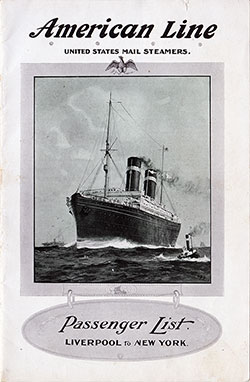Ellis Island Passenger Lists - 1916
Passenger lists for 1916 represent the souvenir list provided to the passengers of each cabin class (and other classes). Many of these souvenir passenger lists have disappeared over the years. Our collection primarily covers North American and European ports and ports in Australia and South Africa.
Our collection contains samples of passenger lists produced and printed by the steamship lines. These lists are often used to illustrate family history books for immigrants from this period.
Coveted by collectors and genealogists, souvenir passenger lists often offered beautiful graphical covers and information not found in official manifests because they focused on the journey rather than the destination.

1916-09-09 SS St. Paul Passenger List
Steamship Line: American Line
Class of Passengers: First and Second Class
Date of Departure: 9 September 1916
Route: Liverpool to New York
Commander: Captain A. R. Mills

1916-11-14 SS Frederik VIII Passenger List
Steamship Line: Scandinavian America Line / Skandinavien-Amerika Linie
Class of Passengers: First and Second Cabin
Date of Departure: 14 November 1916
Route: Copenhagen to New York
Commander: Captain A. G. Thomsen
Please help us make our passenger list collection more complete. We would appreciate a digital copy if you have an 1916 souvenir passenger list. Please email us at history@ggarchives.com.
Recap and Summary of the Ellis Island Passenger Lists - 1916
The Ellis Island Passenger Lists for 1916 provide a fascinating glimpse into transatlantic travel during one of the most dangerous years of World War I. With the war at its peak, passenger and cargo ships alike were under constant threat from German U-boats, leading to fewer transatlantic voyages and heightened security measures for those that did sail.
By 1916, Germany's unrestricted submarine warfare had intensified, causing Allied and neutral nations to modify their shipping strategies. Many luxury liners had been converted for wartime use, and neutral ships became more critical in keeping passenger routes open.
Notable Highlights from the 1916 Passenger Lists
1. SS St. Paul (American Line) – 9 September 1916
- Route: Liverpool to New York
- Class of Passengers: First and Second Class
- Commander: Captain A. R. Mills
- Significance:
- The SS St. Paul was one of the few remaining American transatlantic liners still in civilian operation, at a time when many passenger ships had been repurposed for wartime duties.
- The risk of U-boat attacks was high, meaning that ships like the St. Paul had to take extreme precautions, including traveling in zigzag patterns and reducing lighting to avoid detection.
- The ship was later used by the U.S. Navy in 1917, just a few months before America officially entered the war.
2. SS Frederik VIII (Scandinavian America Line) – 14 November 1916
- Route: Copenhagen to New York
- Class of Passengers: First and Second Cabin
- Commander: Captain A. G. Thomsen
- Significance:
- The Frederik VIII belonged to Denmark, a neutral nation during World War I, making it a safer option for transatlantic travel.
- By 1916, neutral ships like this one became essential for carrying refugees, diplomats, and travelers who sought to avoid war zones.
- The ship was known for transporting European immigrants, many of whom were fleeing the deteriorating conditions in war-torn Europe.
Key Historical Events That Affected Steamship Travel in 1916
1. Intensification of German Unrestricted Submarine Warfare
- Germany had begun attacking ships indiscriminately, leading to the sinking of numerous passenger liners and merchant vessels.
- This dramatically reduced the number of transatlantic voyages, with most passenger ships either repurposed for military use or sailing under extreme caution.
- The Allies responded by arming merchant ships and implementing convoy systems to protect critical supply routes.
2. The Sinking of the RMS Sussex (March 24, 1916)
- A German U-boat torpedoed the RMS Sussex, a cross-Channel ferry, injuring several American passengers.
- This further increased tensions between the United States and Germany, leading Germany to temporarily halt unrestricted submarine warfare in an effort to avoid provoking U.S. intervention.
- Despite this, attacks on neutral and civilian vessels continued, making transatlantic travel perilous.
3. The Expansion of Neutral Ship Travel
- As Allied ships became prime targets for German submarines, neutral liners, particularly from Scandinavian countries and the Netherlands, became the safest options for civilian passengers.
- The SS Frederik VIII was an example of this trend, as Denmark remained a neutral hub for war refugees and transatlantic travelers.
4. The Increasing Role of American Steamship Lines
- With European liners increasingly at risk, American-flagged ships became vital for passenger and cargo transport.
- Ships like the SS St. Paul continued to sail, but by 1917, many were requisitioned for wartime service as the U.S. moved closer to entering the war.
Conclusion – 1916: The Last Full Year of Civilian Transatlantic Travel Before U.S. Involvement in WWI
- 1916 was a pivotal year for ocean liner travel, with many ships being repurposed for military use and others sailing under the constant threat of attack.
- German U-boat warfare drastically reduced the number of passenger voyages, making neutral Scandinavian and Dutch ships more crucial than ever.
- By 1917, the United States would enter the war, further disrupting transatlantic travel and leading to the full militarization of many civilian liners.
- The passenger lists from this year represent one of the last glimpses of civilian travel before the world was completely engulfed in wartime naval conflicts.
